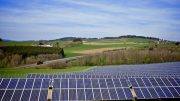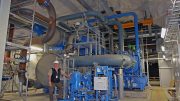Nebraska’s largest electric utility could dramatically reduce carbon emissions over the next three decades at little or no cost to ratepayers, according to a pair of recent reports prepared for the utility’s board of directors.
The path — and cost — of completely eliminating emissions by midcentury, though, becomes far less certain.
The Nebraska Public Power District, which serves most of the state’s population outside the cities of Omaha and Lincoln, last year hired two firms to forecast the potential impact of federal carbon regulations. The results, by Ascend Analytics and Siemens, both conclude that the utility could significantly reduce its exposure to such policies without burdening customers with severe rate hikes.
Ascend’s study said that if wholesale power prices continue to fall, the utility likely could cut its carbon emissions by 90% without any added expense. It predicts a dramatically higher price for eliminating the final 10% of emissions, concluding the only economically feasible way to eliminate them would be through offsets.
The study’s modeling exercises consistently endorsed closing coal and nuclear plants before 2036, when many of their sales contracts to retail utilities would expire, and investing in wind, solar and some combination of batteries and “flexible” natural gas.
The analysis by Siemens is slightly less sunny. It predicts that substantial carbon reductions can be achieved with modest increases in prices for customers until perhaps some time after 2040. Siemens estimates that the utility could, for example, chop its carbon intensity in half by 2030 and by 80% by 2050 while increasing rates to its utility and municipal customers by no more than the rate of inflation. Getting to 100% carbon-free electricity by 2050 would be significantly tougher, according to the study, and likely would require doubling customer rates between 2035 and 2050.
Siemens’ models also endorsed closing the utility’s coal giant, the 1,365-megawatt Gerald Gentleman Station, before 2036. However, it said that attaining 100% clean energy might require relicensing the Cooper Nuclear Station, a costly proposition. Both studies recommend closing the 225-megawatt coal-fired Sheldon Station early or converting it to operate on natural gas.
“For years, we’ve been saying, ‘You should retire your coal-fired generation and replace it with clean energy,’” said John Crabtree, a Sierra Club Beyond Coal campaign representative in Nebraska. “Ascend Analytics made the case that NPPD needs to retire much of their coal-fired generation and replace it with clean energy.”
And particularly significantly, he added, “Their rationale was that this was the best economic case.”
The Nebraska utility’s board of directors will use the reports to develop a sustainability goal, and then to devise an integrated resource plan starting later this year.
Dave Millar, the Ascend report’s lead author, cautioned that, like all attempts to predict the future, this study relies on assumptions. One of his major assumptions was a continued and persistent fall in the cost of power, mostly due to the addition of solar and wind generation, very cheap because they require no fuel. That likely will allow the utility to both cut its emissions and keep prices in check, Millar said.
Authors of both reports agreed that power prices will tumble in the coming decades with the addition of renewable generation, and that the district likely will morph from exporting to importing electricity. In all likelihood, the utility simply will not be able to generate power for less than it will pay for it in the coming years, Millar said.
Mary Harding, the chair of the utility’s board, while not endorsing any particular moves, said the reports clarified for her that the company must expand its vision.
“We used to talk about affordability and reliability as the imperatives. Now I think we have a three or four-legged stool. We need sustainability and resilience. How we achieve that is the $64,000 question. Both reports suggested we might consider being a net importer rather than a net exporter. I had never considered that as having an economic advantage to ratepayers. I am not saying that because they suggested that’s what we need to do. It opened up new options we need to consider.”
As renewables provide an ever-larger share of the power in the Southwest Power Pool marketplace, Millar said the mix of resources online at any moment will become more volatile. The grid operator reshuffles the mix of generators every five minutes, and changes will come at ever-greater speed as more of the generation is subject to the whims of the sun and wind.
That, in turn, means the system will need to fill in with some combination of nuclear power, batteries and natural gas. Both the Ascend and Siemens studies call for at least one of those, especially in a few decades as renewables provide a much larger share of the power available.
Crabtree takes issue with the consultants’ “lumping batteries and gas together. They’re not the same kind of assets. One is going to end up stranded, and one’s not.”
Millar pointed out the limitations of batteries. While both batteries and “flexible” gas could provide some power when the wind and sun are not performing, he warned that batteries are limited by the fact that they don’t produce power, only hold onto it.
To eliminate all carbon emissions, the Siemens models call for investment in 290 MW of combustion turbine gas capacity — the type of gas technology that ramps up and down relatively quickly — and relicensing the Cooper Nuclear Station, predicted to be a very expensive option.
However, these options likely would not come into play for many years, Millar pointed out. The shorter-term outlook is clearer, and appears doable, he said.
“We think we can get to an 80% or 90% reduction with today’s technology. It’s the last 10% to 20% that we don’t know yet. We need for technology to come down in cost, or we need new technologies.
“I don’t think people should sweat the last bit. The technology is going to improve. You certainly could do a lot to decarbonize now.”
by Karen Uhlenhuth, Energy News Network
March 29, 2021
This article first appeared on Energy News Network and is republished here under a Creative Commons license.





